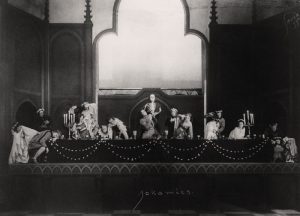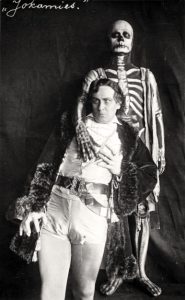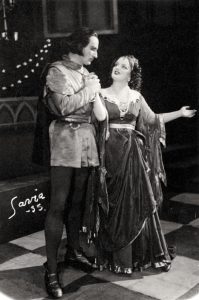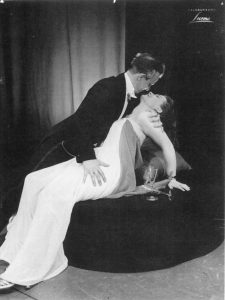Click here to download this article as a pdf file
Sibelius’s music for Everyman
Eija Kurki

Everyman at the Finnish National Theatre in 1935.
Death arrives to claim Everyman in the middle of the banquet.
Photo: Finnish National Theatre archive / Eija Kurki
An extensive output of music for the theatre is one of the most significant areas of Sibelius’s œuvre, and many world-famous works – including Finlandia, the Karelia Suite and Valse triste – were originally composed in the context of music for the stage. Sibelius’s wide-ranging theatre music includes a one-act opera, two major sets of music for tableaux, and varying amounts of music for eleven plays and a ballet-pantomime.
As an orchestral composer Sibelius’s collaboration with the world of theatre began in the 1890s with the one-act opera Jungfrun i tornet (The Maiden on the Tower) and incidental music for Adolf Paul’s play Kung Kristian II (King Christian II). At the beginning of the twentieth century he composed a number of theatre scores on subjects combining elements of dreams, death and exoticism. These included incidental music for Arvid Järnefelt’s play Kuolema (Death, from which Valse triste originates) and for Hjalmar Procopé’s Belshazzar’s Feast. Sibelius’s last stage score was written in 1925 for William Shakespeare’s play The Tempest.
Educative morality
The music that Sibelius composed for the Austrian Hugo von Hofmannsthal’s play Jedermann (Jokamies; Everyman) in 1916 was the result of a commission from the Finnish National Theatre. In 1911 Hugo von Hofmannsthal (1874–1929) had written a new version of the ancient English morality play Everyman, and for the performance at the Finnish National Theatre it was translated into Finnish by Huugo Jalkanen. By a strange coincidence, the play was being staged at the same time at the Swedish Theatre in Helsinki, but there the music was by Einar Nilson and Giovanni Pierluigi da Palestrina.
The purpose of this morality play was to teach people that their earthly existence is transitory. Everyman lives a carefree life with his friends and his mistress, Paramour. He gathers worldly goods and scorns requests from the needy. Death comes to claim him, but he is saved from destruction by turning to religion. The play contains allegorical figure: Death, Good Works, Faith, the Devil and Mammon.
Sibelius wrote music for this religious play when the First World War was raging. In the autumn of 1916 he planned the composition of Everyman alongside the revision of the Fifth Symphony. In September 1916 Sibelius wrote in his diary about composing Everyman: ‘I think I have it in my grasp’ and, a week later, ‘Am forging Everyman. And I am worried about the revision of the symphony’. Between the beginning of September and early October he wrote the sixteen musical numbers that make up the score.
The theatre director Jalmari Lahdensuo had commissioned the music in the spring of 1916. He had seen the play in Dresden, and used that production and scenography as his model. Lahdensuo went to visit Sibelius at Ainola in connection with the composition work, and Sibelius in turn met up with Lahdensuo in Helsinki, where the director showed the composer a scale model of the stage setting.
The Première
The first night of Everyman took place on 5 November 1916 at the Finnish National Theatre. For the performance black material had been stretched between the white pillars on stage, with the result that the whole stage seemed to be virtually framed in black.
According to the theatre critics, this created a darkly festive, oppressive mood. Sibelius’s music was praised and, in particular, it was said that without the music the play would have made a weak impression. In addition, the close relationship between the drama and the music was emphasized. The performers at the première were the Helsinki Philharmonic Orchestra conducted by Robert Kajanus.

The 1916 production: Everyman and Death (Urho Somersalmi and Eero Kilpi)
CC BY 4.0 licence
The historical and political situation in Finland in 1916, a year before independence, is reflected in one detail pertaining to the first night. The first night was originally planned for 3 November 1916. That day, however, was the anniversary of Tsar Nicholas II’s accession, which was marked with a national day of celebration. Performing this play with its black scenery was therefore out of the question, and the première was postponed by two days.
The next time the play and Sibelius’s music functioned as a genuine expression of mourning was in Tampere in 1929, following the sinking of the steamship Kuru in a storm with the loss of 138 lives. In the wake of this major disaster the theatre was quick to include Everyman in its schedule. The performance was rehearsed within a two-week timeframe and the music was arranged for smaller forces (at Sibelius’s request) by Hans Aufrichtig, one of the conductors at the Finnish National Opera. These performances left audiences moved to silence.
The Helsinki première and the Tampere performance were both directed by Jalmari Lahdensuo, and he directed the play with Sibelius’s music again in Turku in 1930, with the Turku Philharmonic Orchestra.
Birthday Performances
Everyman featured in the National Theatre programme again in 1935, on the occasion of Sibelius’s seventieth birthday. It opened on 11th December, three days after the birthday itself. Before the performance Sibelius expressed through the director his wish that the audience should not applaud, in order not to destroy the solemn atmosphere of the performance. The reviewer from the newspaper Ilta-Sanomat described the mood of the first night: ‘No other first night at the National Theatre this season ended in such an all-pervading and earnest mood as yesterday’s. After the curtain had fallen, the audience stayed silently in their seats for a long time and then left the auditorium in silence.’

The 1935 production at the Finnish National Theatre
Urho Somersalmi as Everyman and Ruth Snellman (Sibelius’s daughter) as Paramour.
Both also took part in the 1916 performances, Somersalmi as Everyman and Snellman in a minor role as one of the young women.
Photo by Tyyne Savia / CC BY 4.0 licence
In connection with this performance, the director Glory Leppänen, who had studied at the Max Reinhardt Seminar in Vienna in 1933–34, wrote in her memoirs of Sibelius’s demand that ‘the music must follow every beat of the text, because the note-lengths reflect the words themselves. No deviation from this should be allowed. The delivery of the text should be made to suit the music; this was not negotiable.’ The role of Paramour was played by Sibelius’s daughter Ruth Snellman, and the orchestra was conducted by his son-in-law Jussi Jalas.
In the decades that followed, the play with Sibelius’s music – either in its original form or in various arrangements – was performed frequently. Especially during the 1950s there were performances in various cities, some of which remained on the schedules for several years, for instance in Sibelius’s birth town, Hämeenlinna. In Turku there were performances in front of the cathedral, following the example of the Salzburg Festival. In these performances Sibelius’s music was arranged for organ, and was thus heard from within the cathedral. There was also a radio broadcast from the steps of Turku Cathedral in 1957.

Tapio Hämäläinen as Everyman and Anja Pohjola as Paramour at the
Hämeenlinna production in 1956.
Photo: Atelier Luoma, Hämeenlinna City Theatre
Everyman was performed with Sibelius’s music at the Finnish National Theatre in 1965, to mark the centenary of Sibelius’s birth. This performance formed part of the Helsinki Sibelius Weeks.
The most recent theatre production of Everyman with Sibelius’s music took place in Kouvola in 1971; this open-air performance in front of the Town Hall involved an orchestra, choir and a large number of other performers.
Following the Drama
Sibelius’s Everyman, Op. 83, is scored for two flutes, oboe, two clarinets and bassoon, two horns, two trumpets, timpani, piano, organ, strings and mixed chorus.
In the first half of the play there are a number of songs for which Sibelius provided appropriate music. In the latter part of the play, on the other hand, we find music that is designed to form a background to the dialogue. Everyman’s scenes with Good Works, Faith and the Devil each have separate musical numbers in which the music is heard beneath the text.
The play treats a religious theme, and this is evident both from the orchestral texture and from the melodies, harmonies and sonorities. In particular the use of organ and bells indicates a religious connection. Many similarities can also be found with Sibelius’s other works, especially the symphonies.
Sibelius’s biographer Erik Tawaststjerna’s searching analysis of Everyman summarizes the essence of the music: ‘In 1913, three years before the Everyman score was written, Sibelius had foretold that the trendsetters in the religious music of the period would be music in the style of Scriabin and opera. Now he gave an indication of how he envisaged his own religious music. Behind the sacred sections of the Everyman score lie not only the Fourth Symphony’s expressionist-aphoristic sound-world characterized by the tritone, but also the Fifth Symphony’s chromaticism, and the atmosphere of a mystery play.’

The 1935 production at the Finnish National Theatre
The last scene of the play, with the angels. Everyman (centre) with Good Works and Faith. The director Glory Leppänen (daughter of the opera singer Aino Ackté) had studied at the drama school ‘Max Reinhardt Seminar’ in Vienna in 1933–34, where she came into contact with Reinhardt himself. Reinhardt directed the première of Everyman in Berlin in 1911 and numerous later performances as well, e.g. the famous Salzburg performances from 1920 onwards.
Photo by Tyyne Savia / CC BY 4.0 licence
Concert performances and radio broadcasts
Sibelius composed his Everyman music to be part of a drama, and thus the musical numbers were not really intended to be performed without the action on stage. Sibelius probably took this aspect into consideration, as he did not rework the score into an orchestral suite or independent pieces as he had done with many of his other theatre scores (e.g. Valse triste and Scene with Cranes from Järnefelt’s Kuolema). Sibelius did, however, plan an orchestral suite in 1925, but this never became a reality. From this material he arranged three piano pieces: Episodio, Scena and Canzone. If an orchestral suite or indeed the original theatre score had been published, Sibelius’s Everyman music would surely have become widely known in German-speaking countries, as the play is often performed there. In 2018 it still remains unpublished, although the rights to it are owned by Breitkopf & Härtel, and the material is available for hire.
Despite its close connection with the text, the music for Everyman has also been performed in concert. For example, it was in the concert repertoire of the Helsinki Theatre Orchestra. Jussi Jalas, the conductor, relates in his memoirs that the orchestra had great success performing Everyman with the narrator Ella Eronen. These performances took place in the period of the Second World War (the Winter War and Continuation War).
The Finnish Radio Symphony Orchestra and Choir have participated in two recordings of Everyman performances for Yleisradio (the Finnish Broadcasting Company). The first of these (1953) was made for a radio broadcast; the second (1959) was a staged concert performance in conjunction with the Helsinki Sibelius Weeks. These performances had the potential to reach a large audience, as there were a million licensed radio sets in Finland by 1955.
Remarkably, the BBC Third Programme broadcast the music’s first English performance on 13 March 1955, performed by the Goldsbrough Orchestra and BBC Chorus conducted by Dennis Arundell, who had translated Hofmannsthal’s words with reference also to the original English Everyman text. In a review of the performance, the British-based, Austrian-born Hans Keller called it ‘the first work of Sibelius which I can stand and understand’. In addition he wrote that it was a ‘masterpiece, or at any rate a master’s piece’ and that it should definitely be performed in Salzburg. (‘Those who have heard Salzburg’s own incidental music will be aghast when they hear of the existence of the present score.’) In the same review he stated that ‘the score ought to be published at the earliest possible opportunity’. It would surely have been easier to have the music performed in Salzburg if it had been published.
On Independence Day in 1995, the year it recorded the score, the Lahti Symphony Orchestra played it at the Church of the Cross in Lahti, with Lasse Pöysti reciting Hofmannsthal’s text. Since then, however, Sibelius’s music has not been performed together with the play text in Finland, despite its earlier popularity. Sibelius’s music was, however, used at performances of Everyman in Prague in 2015.
© Eija Kurki 1995/2018
Eija Kurki (b. 1963) published her dissertation Satua, kuolemaa ja eksotiikkaa. Jean Sibeliuksen vuosisadan alun näyttämömusiikkiteokset (Fairy-tale, Death and Exoticism. Jean Sibelius’s Theatre Music from the Beginning of the 20th Century) in 1997 at the University of Helsinki and has subsequently continued her research, uncovering much previously unknown information about the plays, Sibelius’s fascinating scores and their performance history, writing numerous articles in various specialist publications both in Finland and internationally (e.g. Sibelius Studies, Cambridge University Press, 2001). She has written the booklet notes for several world première recordings of Sibelius’s music on the BIS label, texts that have won praise from leading Sibelians such as Robert Layton. In November 2024 she published, together with Professor Karl Toepfer from San Francisco, the most comprehensive study of Sibelius’s tragic pantomime Scaramouche, comprising 170 pages.
Since 2017 she has also been researching the Swedish-born theatre composer Einar Nilson (1881–1964), his life and work with director Max Reinhardt.
This article is a revised version of a text that appeared in the newspaper Etelä-Suomen Sanomat on 6 December 1995. English version published in Sibelius One Magazine, January 2018. Translation: Sibelius One.